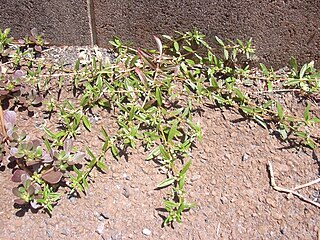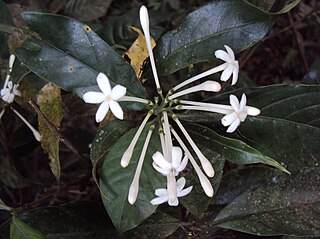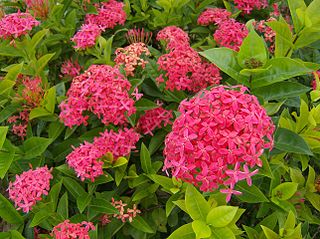
Nesohedyotis is a genus of flowering plants endemic to the island of Saint Helena in the South Atlantic Ocean. It in the family Rubiaceae.

Oldenlandia is a genus of flowering plants in the family Rubiaceae. It is pantropical in distribution and has about 240 species. The type species for the genus is Oldenlandia corymbosa.

Kohautia is a genus of flowering plants in the family Rubiaceae. They are native to tropical areas of Asia, Africa, and Madagascar. Thirty-one species are known. The type species for the genus is Kohautia senegalensis.

Pavetta is a genus of flowering plants in the family Rubiaceae. It comprises about 360 species of trees, evergreen shrubs and sub-shrubs. It is found in woodlands, grasslands and thickets in sub-tropical and tropical Africa and Asia. The plants are cultivated for their simple but variable leaves, usually opposite but also occur in triple whorls. The leaves are often membranous with dark bacterial nodules. Pavetta has small, white, tubular flowers, sometimes salviform or funnel-shaped with 4 spreading petal lobes. The flowers are carried on terminal corymbs or cymes.

Rothmannia is a genus of flowering plants in the family Rubiaceae. It was described in 1776 and is named for Göran Rothman (1739–1778) by Thunberg – both were pupils of Linnaeus.

Tarenna is a genus of flowering plants in the family Rubiaceae. There are about 192 species distributed across the tropical world, from Africa, Asia, Australia to the Pacific Islands. They are shrubs or trees with oppositely arranged leaves and terminal arrays of whitish, greenish, or yellowish flowers.

Vanguerieae is a tribe of flowering plants in the family Rubiaceae and contains about 655 species in 30 genera. It is one of the most species-rich groups within the family and it is distributed across the Paleotropics.

Hedyotis (starviolet) is a genus of flowering plants in the family Rubiaceae. Many species of this genus such as Hedyotis biflora, H. corymbosa and H. diffusa are well known medicinal plants. Hedyotis is native to tropical and subtropical Asia and to islands of the northwest Pacific. It comprises about 115 species. The type species for the genus is Hedyotis fruticosa.

Kadua is a genus of flowering plants in the family Rubiaceae. It comprises 29 species, all restricted to Polynesia. Twenty-two of these are endemic to the Hawaiian Islands. Some of the species are common at high elevation. Others are single-island endemics or very rare, and a few are probably extinct. Kadua affinis is widely distributed in Hawaii and is polymorphic. The type species for the genus is Kadua acuminata.
Amphiasma is a genus of 7 species of flowering plants in the family Rubiaceae. It was described by Cornelis Bremekamp in 1952. The genus is found from southern Tanzania to Namibia.
Amphistemon is a genus of 2 species of flowering plants in the family Rubiaceae. It is described by Inge Groeninckx in 2010 based on a molecular analysis of the Hedyotis-Oldenlandia group. The genus name is based on the Greek 'amphi-' and 'stemon' (=stamen) referring to the dimorphic stamen position characteristic for this genus.
Virectaria is a genus of flowering plants in the family Rubiaceae. The genus, known as Virecta until 1952, consists exclusively of tropical African species. It is a Guineo-Congolian genus, having its highest diversity in Lower Guinea but it also occurs in the Zambezian Region. Verdcourt provided a revision in which he defined five species but three more were added later. In 2001, a detailed morphological and anatomical study of the genus was conducted and a taxonomic survey and a key to the species was provided.
Cornelis Eliza Bertus Bremekamp was a Dutch botanist.
Exallage is a genus of flowering plants in the family Rubiaceae. The genus is found from tropical and subtropical Asia to the southwestern Pacific.

Ixoroideae is a subfamily of flowering plants in the family Rubiaceae and contains about 4000 species in 27 tribes.
Carterella is a monotypic genus of flowering plants in the family Rubiaceae. The genus contains only one species, viz. Carterella alexanderae, which is endemic to Baja California Sur in Mexico. It grows on steep slopes in the mountains.

Rubioideae is a subfamily of flowering plants in the family Rubiaceae and contains about 7600 species in 27 tribes.

Spermacoceae is a tribe of flowering plants in the family Rubiaceae and contains about 1346 species in 57 genera. Its representatives are found in the tropics and subtropics.

Stenaria is a genus of flowering plants in the family Rubiaceae. It is a small genus, consisting of around six species native to the United States, Mexico, and The Bahamas. All species of Stenaria are restricted to Mexico and the southwestern United States, except for the wide-ranging Stenaria nigricans which extends northward and eastward.














